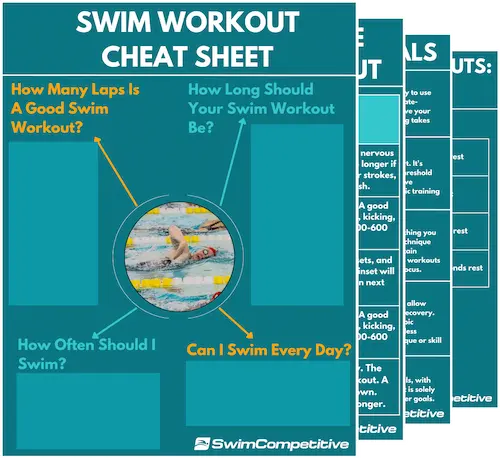Do you want to take your swimming to the next level? If so, you might want to consider adding weight training or dry-land strength training to your schedule. Added strength training has proven beneficial for many swimmers and has allowed them to enhance their swimming performances.
It is, however, important to have a good understanding of weight lifting before you start pumping some iron. There are some key points to take into account. One of these considerations includes when it would be best for you, as a swimmer, to start lifting.
Or to put it in other words- at what age should swimmers starting lifting weights? Personally, and I know a lot of the good strength coaches and trainers will agree with me, I don’t like to use a specific age as a restriction for when swimmers “should” start lifting weights.
The reason is simple- everyone develops at a different rate, both physically and mentally and in reality, there is no magic age number for when it would be best for a swimmer to start lifting weights. Allow me to explain-
Since everyone develops at different rates, you may have a 16-year-old with the body and mental maturity of a 13-year-old. Do you think it is going to be a good idea for this swimmer to lift weights? Probably not.
At the same time, you could have a 13-year-old with the maturity and physical characteristics of a 16-year-old. Now, do you think we should restrict this athlete from lifting just because they aren’t “16” yet? Definitely not, that is only going to limit them and their potential as a swimmer.
Sure, any swimmer new to dry-land strength training or weight lifting should start with basic bodyweight exercise progressions before starting to lift weights. This will ensure that they have enough strength to do the exercises properly and correctly. It will also prevent injuries in the long term.
So to answer your question of when swimmers should start lifting weights-
Swimmers should start lifting weights once they are able to dedicate their full mental focus to each training session in the gym and have the required physical strength to crush all basic bodyweight exercises such as pull-ups, push-ups, dips, squats, etc.
But before you run off to the gym to lift some weights, stick around so that we can cover some more of the fundamentals that you need to understand before starting to lift weights.
Let’s start by looking at the steps swimmers should follow as they prepare to start lifting weights.
Getting Started with Weight Training: Following the Right Steps
Bodyweight Training and the Right Exercise Progressions for Swimmers
Before swimmers can even think about going into the weight room they require some basic strength, as well as an understanding of how to control their bodies for certain dryland exercises and movement patterns.
These fundamentals can easily be obtained through some basic bodyweight training exercises and routines. I recommend swimmers who are brand new to dry-land strength training to start out with a minimum of 12 to 16 weeks of bodyweight training before progressing to the weight room, even if you feel that you are ready for it earlier.
Start by building up some basic strength through exercises such as push-ups, pull-ups, dips, bodyweight squats, lunges and so on. Slowly increase the reps and sets as you become stronger and focus on getting enough recovery between workouts.
Once you have built up a base of strength and understanding for how dry-land training works you can progress to the weight room.
In the gym or the weight room, you are going to start out by learning the basic exercise technique for fundamental strength training exercises such as the bench press, back squat, deadlift, and overhead press.
You aren’t even going to think about touching the weights for the first 2-3 weeks, your focus is solely on technique. I recommend recording yourself to see how you are performing the exercises or even hiring a trainer to help you learn proper technique.
Then once you’ve got some decent technique you can start adding weight to the bar in order to become a stronger swimmer.
If you want to learn how to create your own weight training program, I’ve written an article explaining exactly how to do so, you can check it out by clicking here.
Progressive Overloading: How Swimmers Can Become Stronger
Once you’ve added some weight to the bar your body is naturally going to become stronger and adapt to that external resistance.
That’s why it is important to slowly and gradually increase the resistance as you become stronger, we call this progressive overloading and it can be done in 3 main ways-
The first way is to simply add more weight to the bar. I don’t recommend adding more than 2.5-5 pounds to the bar each week
The second way to progress is to increase the number of sets you do, I recommend keeping it to 5 sets at the maximum since recovery may become an issue if you go any higher than that.
The third way is going to be to increase the number of repetitions you do. Generally, I don’t recommend swimmers to do this since we aren’t training for muscle mass, but rather general athletic strength. This requires low repetition training of roughly 3-6 reps per set.
Mobility and Flexibility: What Swimmers Should Know
When we start lifting weights your muscles may sometimes become a bit tight and sore. This is going to limit your mobility and flexibility from time to time, which isn’t the end of the world since it is only temporary.
But over time repetitive weight training can cause tension to build up in muscles and tendons. This can negatively impact swimmers by limiting mobility and flexibility in the water. Luckily, there is evidence that weight lifting combined with static stretching can actually increase flexibility.
That’s why it is important for swimmers to ensure that they are doing at least 20 minutes of daily full-body static stretching if they decide to lift weights or do other forms of dry-land training.
Training Reps, Sets, and Frequency: a Swim-Specific Approach
When swimmers hit the weight room the focus is going to be mainly strength and power development, not muscle development. Sure, with added strength comes added muscle, but the idea isn’t to look like a bodybuilder.
By taking a look at a meta-analysis published in the Journal of Sports Medicine by researchers Emmet Crowly, Andrew J. Harrison and Mark Lyons, it is clear that low volume, high force resistance training programs are most optimal for improving swimming performance and overall stroke length in the water.
Swimmers are generally recommended to follow a low repetition approach in order to optimize strength results. This means roughly 3-6 repetitions for 3 to 4 sets of each exercise.
In terms of frequency, I recommend swimmers who are new to lifting weights to hit the gym 3 times a week with at least a day recovery in between sessions. For example- train on Monday, Wednesday, and Friday and rest on the other days.
If you are interested in checking out my list of the some good strength exercises for swimmers, you can do so by clicking here.
Do You Want to Make Every Lap Count?
Stop wasting your time in the pool feeling lost and doing directionless swim workouts, and start training effectively! Our ebook contains 97 structured and goal-orientated swim workouts to help you become a better, faster, and fitter swimmer. Whether you’re a complete beginner or a seasoned pro, there are a multitude of workouts for every type of swimmer.
Benefits of Weight Lifting for Swimmers
1. Increased Strength, Endurance, and Power Equals Faster Swimming
Weight lifting is known for being one of the best ways to increase both raw and athletic strength. Lifting weights increases strength by making your muscles work against an external resistance or force, ultimately creating tiny micro-tears in the muscle fibers.
Once, the muscle repairs itself you will be a little stronger than before and if you are patient you can build up a lot of extra strength over time.
Weight lifting is also a great way to increase power output. This will allow you to have stronger and better dives and push-offs from the blocks and walls during your races and it can also allow you to exert more powerful strokes and kicks while swimming.
Increased strength and power has been proven to have correlations between sprinting swimming performances. A study published by the Journal of Human Kinetics looked at the associations between dry-land strength and power measurements with swimming performance in elite swimmers.
The study used 10 male national level swimmers who volunteered as subjects. Strength and power in the propulsive swim phases were assessed using the squat, bench press, and lat pull down.
The study ultimately concluded that measured strength and power showed high correlations between dry-land and in water swimming performance. The squat associated with leg force production in the water, while the bench press and lat pull down associated with arm dominated propulsive force while swimming.
Make sure to check out my weight lifting guide if you are interested in learning a bit more about the topic and ultimately becoming a better swimmer, you can do so by clicking here.
2. Weight Lifting Can Help Swimmers to Prevent Injuries
Many people are under the belief that weight lifting is one of the main reasons athletes get injured. This is, however, simply not the truth- taking into account that you are performing the exercises with proper technique and not using weight that is too much for you to lift while maintaining good exercise form.
Sure, if you are going to be reckless in the weight room you are going to get injured. It is as simple as that and by reckless I mean not taking the time to learn proper exercise technique and simply piling as much weight as possible onto the bar to satisfy your ego.
However, if you are willing to spend the time to learn good exercise form and slowly progress to lifting heavier as you get stronger, then you are only going to strengthen muscles that could have otherwise been prone to injury through overuse in the pool.
Lifting Weights Can Provide Swimmers with the Mental Readiness to Swim Fast
One of the best ways to be mentally prepared to swim fast is to be physically prepared.
What I mean by this is- if you are putting in the work in the pool and the weight room you will build up confidence in knowing that you have done everything you possibly could to prepare for this swim meet and that you have nothing to worry about.
Confidence and the belief that you are able and prepared to swim fast is one of the biggest factors contributing to your physical success. If you don’t believe you can swim fast, you probably won’t, but if you believe that you can because you have done everything to prepare to do so, you probably will.
The man who thinks he can and the man who thinks he can’t are both right.
-Henry Ford
You are fueling your mind and body for success by working hard in practice.
Want to know if you should lift weights before or after swimming? Check out our article on the topic by clicking here.
Swim Faster by Lifting Weights
Lifting weights can be very beneficial for swimmers by enhancing swimming performances in the pool and preventing long term injuries. It can also increase flexibility and mobility when combined with daily static stretching.
I recommend swimmers start lifting weights once they have reached a strong level of mental maturity and good physical shape, regardless of what age they are.





